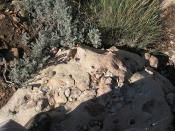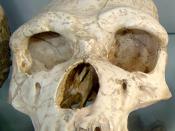Fossil is the mark or remains of an organism that lived thousands or millions of years ago. Some fossils are leaves, shells, or skeletons that were preserved after a plant or animal died. Others are tracks or trails left by moving animals. Most fossils are found in sedimentary rocks. These fossils formed from plant or animal remains that were quickly buried in sediments -- the mud or sand that collects at the bottom of rivers, lakes, swamps, and oceans. After thousands of years, the weight of upper layers of sediment pressing down on the lower layers turned them into rock internet article). A few fossils are whole plants or animals that have been preserved in ice, tar, or hardened sap (internet site).
The oldest fossils are microscopic traces of bacteria that most scientists believe lived about 3 1/2 billion years ago (class notes). The oldest animal fossils are remains of invertebrates (animals without a backbone) estimated to be about 700 million years old.
The oldest fossils of vertebrates (animals with a backbone) are fossil fish about 500 million years old.
Fossils are more common and easier to find than many people realize. For example, fossils are plentiful in nearly every state in the United States. Even so, scientists believe that only a small portion of the countless plants and animals that have lived on Earth have been preserved as fossils. Many species are thought to have lived and died without leaving any trace whatsoever in the fossil record.
Although the fossil record is incomplete, many important groups of animals and plants have left fossil remains. These fossils help scientists discover what forms of life existed at various periods in the past and how these prehistoric species lived. Fossils also indicate how life on earth has gradually changed over time. The...



Interesting...
I have always been attracted to the work of a paleontologist. Good grammar in your essay, was quite fluent, and an interesting topic as well. Looking forward to reading more of your work. ;)
1 out of 1 people found this comment useful.